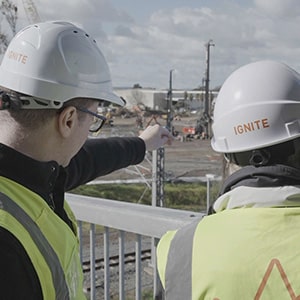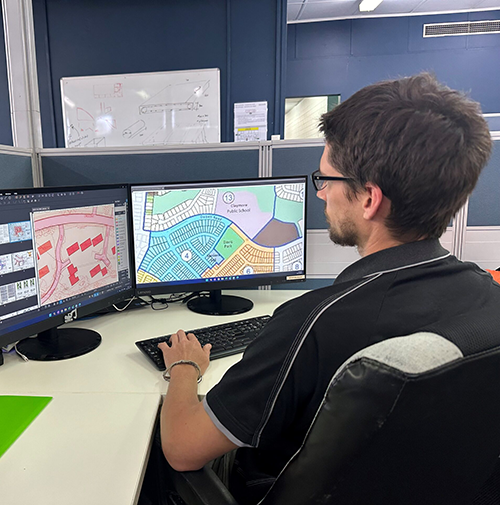
From holiday resorts to hospitals, zoos to commercial properties, schools to entertainment precincts and everything in between, Ignite Architects’ span of construction design is both diverse and challenging.
Winner of a raft of 2023 New Zealand Property Industry Awards—including the Supreme Excellence Award for its work toward the development of New Zealand’s Wellington Children’s Hospital—Ignite is home to a specialised team of about 190 architects, designers and technicians, operating from six design studios across New Zealand and Australia.
Delivering concurrent and diverse projects across multiple time zones means that the mechanisms used by the business are central to its ongoing success and growth. And in response, over the past five years Ignite has been focused on its integration of technology to enhance productivity, accuracy and collaboration across its locations.
This led Ignite to invest in Bluebeam, optimising collaboration, building delivery and client outcomes.
“We were looking for something that aligned with our workflows and through our evaluation process Bluebeam simply came out on top—it was a match for our business, our workforce and the diversity of the work we do,” Ignite Architects Associate Director and Group Technology Manager Jeremy Benseman said.
“Some staff were using Adobe for markups, but most people felt it was incredibly difficult,” he added. “It wasn’t an easy workflow, so generally what was happening was people were printing the drawings physically and hand backing them up and scanning them back into PDF. It simply wasn’t sustainable.

Battling outdated ways of working
According to Benseman, before the implementation of Bluebeam the flow of information went back and forth across the organisation’s six studios; its clients and business partners were disconnected.
“At its core, the tools weren’t intuitive—if you’re putting notes on things and tagging and then it’s quite a challenge to get them the right scale and size and font …. and there’s just no interface that enables ease of use,” Benseman said.
“We were looking for something that aligned with our workflows and through our evaluation process Bluebeam simply came out on top—it was a match for our business, our workforce, and the diversity of the work we do.”
Jeremy Benseman
Associate Director and Group Technology Manager
Ignite Architects
“Around the time we were looking to make the decision, we had just bought these tablets that we can plug into our laptops so we could markup. And when we were testing that with the various software solutions, Bluebeam was really the only one that kind of interacted nicely with that. And you know …. being architects, people want to use a pen so that was important. A lot of our senior staff use touch screen laptops with pens, and they are able to complete their markups in Bluebeam using the pen, while the other vendors don’t really offer the same kind of experience.”
For Ignite, the implementation of Bluebeam was swift.
Renewal of incumbent software was impending, which Ignite saw as an opportunity to make a definitive move. “As a result, the whole implementation was undertaken within a month …. and that was surprising,” Benseman said. “That’s probably one of the best that we have done in terms of new software, introducing and fully integrating a new solution while completing shelving the previous platforms.”
With multiple senior staff across who favoured hand drawing, an important feature Bluebeam offered was a digital interface that enabled the same “pen to paper” experience.
“That’s part of the reason that Bluebeam fitted. A lot of the other products didn’t and at the price point, Bluebeam’s bang for buck was far better than the competitors,” Benseman revealed.
“Our decision to transition was also occurring during the pandemic, so we didn’t really have that ability to print the drawings off and scan them because no one was really in the studios. We needed a solution that would work for everyone—no matter where they were based.”
Ignite initially invested in 90 seats but quickly expanded as the software proved to be a valuable asset for the firm’s projects and communication. The ability to conduct live collaboration sessions, share markups and create standardised workflows significantly improved productivity and streamlined the document management process for the business.

Bridging global divides
A key outcome for Ignite in implementing Bluebeam was in improving workflows, communication and accuracy with overseas partners.
Bringing in Bluebeam Studio Sessions enabled the business to collaborate live—in real time—and to share and then build markup workflows.
“Being able to enter into live sessions with teams in other countries in effect means we are standing around the figurative table looking at the same design and markup and making changes together,” Jeremy said.
“We collaborate particularly with our Vietnam partner, and they saw the communication and workflow benefits of that as well to the point where they started to buy more licenses. The Bluebeam solution addressed the language barriers and distance and time zones—which is critical in a business that operates across the globe.
“Putting packages together quickly from screen grabs out of all the packages of software works well,” Benseman said. “We can enter some notes onto it, and it looks like it’s a presentation—it’s a quick and easy solution.
“I think also because we are predominately Revit based and lot of documentation is produced, having the plugins that natively export to a Bluebeam platform helped with the transition,” he continued. “In the Revit platform, being across multiple organisations, we’ve always struggled with how to output PDF. That plugin really helps.”
Interfacing to deliver iconic projects
Bluebeam has also served as an ideal platform when Ignite has partnered with other organisations to deliver complex projects—such as the $277 million redevelopment at Westfield’s Sylvia Park shopping centre.
Sylvia Park is New Zealand’s biggest shopping mall. For the large format retail centre that Ignite helped design, Bluebeam was used heavily in the resource consent process.
“Partnering on projects such as Sylvia Park requires an advanced level of agility as well as confidence in accuracy—and thanks to Bluebeam we have delivered these outcomes,” Ignite Architects Associate Director Kevin Adasko said.
“And when we are around the table able to effectively contribute to complex projects thanks to a tool like Bluebeam we are building a reputation which gives us a competitive edge.”

How Bluebeam has ignited business success
Introducing any change in a business—no matter how simple—always comes with challenges.
“I definitely recommend for anybody looking at rolling out Bluebeam or using Bluebeam on projects to do a deep dive into the collaboration piece. I think that that is a huge benefit to your project team. It’s clear, it’s concise, it’s trackable, you can review things and comment, and I think that’s the biggest win for us that we’ve found. There are many other advantages of using Bluebeam, but I think that the collaboration piece is one that we’ve found very, very useful.”
Todd Myers
Associate Director
Ignite Architects
For Ignite, the most significant challenge was the speed of change and that the shift did not include a transitionary phase.
“The cut off that was literally a hard cut off—though people knew in advance the challenge was that one day they had Adobe and the next we cut it off and said ‘here’s Bluebeam,’” Benseman confirmed. “In saying that, most people weren’t happy with our existing tools—and the introduction of Bluebeam was important in responding to our team’s concerns.
“Communicating with our people was key—as was training,” Benseman continued. “Through our reseller, Cadpro, we delivered weekly training sessions for a month, which, when coupled with the workplace desire to get a better solution in, meant that everyone was armed with the tools to benefit from Bluebeam from the launch date.
“We used to do everything manually—for instance you loop in one person and then loop in another, but there is nothing there that you can track it with. With Bluebeam we can comment on things. We can also see if someone else has put a comment on it, closed it out or changed colours. This has helped the workflow in the sense that we could track what was happening and who was involved when we collaborated. So rather than getting a set of drawings back that had a blue highlighter through saying it was done, you could actually check and ensure that everyone who was asked to contribute if they had done so, when and how.”
According to the Group Technology Manager, Adobe was “very clunky and not very good for that kind of work, whereas now it’s got that tool set built in and we’re just kind of getting to the point where we created a customised tool set for ourselves that suits Ignite.”
Since the implementation of Bluebeam, Ignite Architects is working to unlock the raft of features and tools Bluebeam offers to optimise its investment in the platform, including building templates and toolkits for users.
The customisation of the platform and its tools presents a high value to Ignite: “Bluebeam offers the ability to shift from being partly technical to more creative and conveying ideas. The flexibility in its customisation has offered real benefits,” Jeremy said.
“We recorded every training session as well, so our people are able to review the sessions. Within two or three months we were already having to find that we needed more seats—people were asking for it. So, we had to get more and more and it just kind of grew from there. So, the buy-in was pretty good. The biggest challenge at this time is to try to get our consultants on it as well, engineers, construction, so we can collaborate more.
“Bluebeam did everything we needed it to do and much more.“





